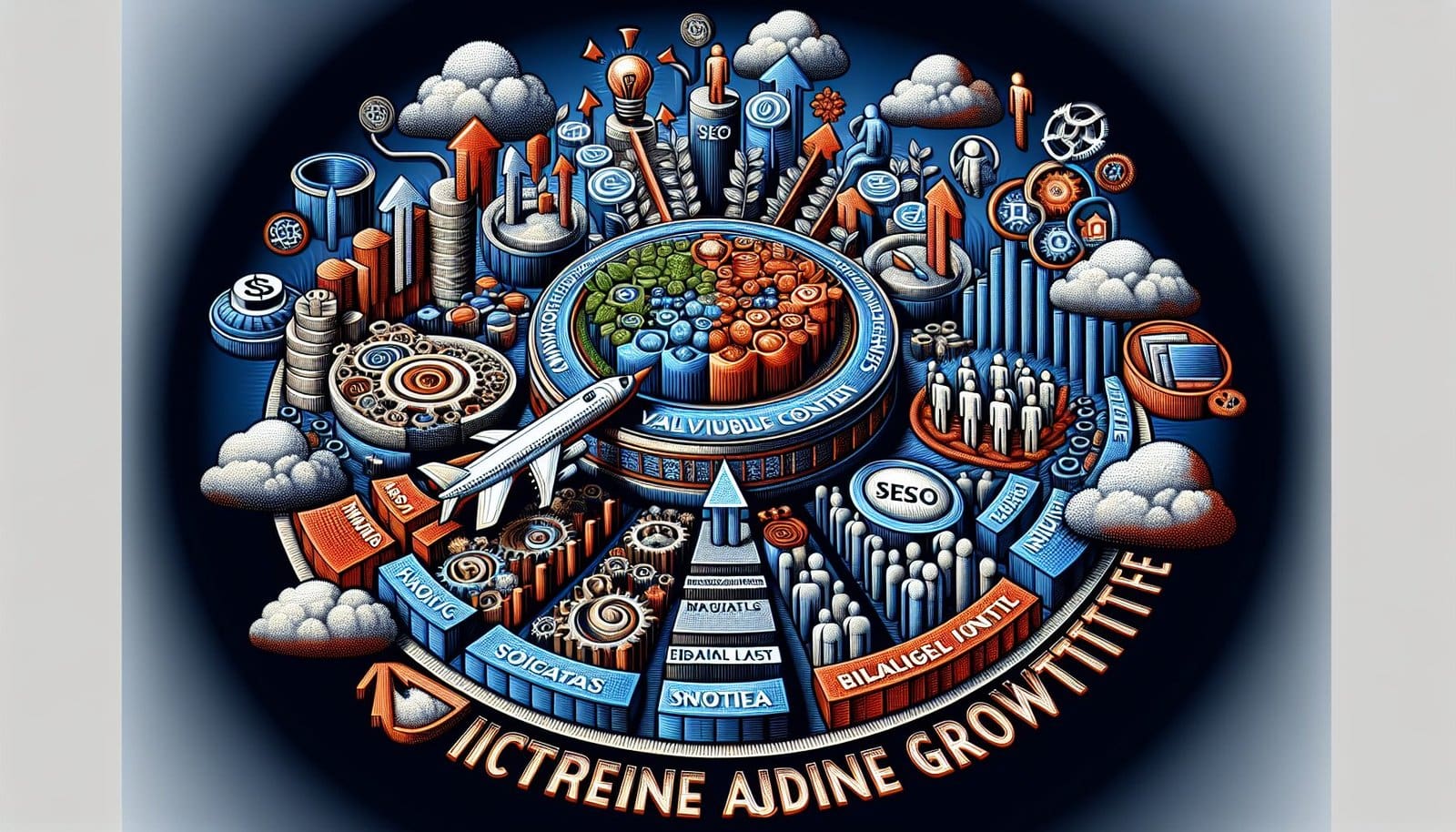Looking to boost your website's audience without breaking the bank? Look no further! In this article, we'll explore a range of free strategies that can help you expand your online presence and reach a wider audience. With these practical tips and tricks, you'll be well on your way to attracting more visitors and increasing engagement on your website. So, let's dive in and discover how you can make the most of these cost-effective techniques to boost your website's visibility in 2024!

Creating High-Quality Content
One of the most effective strategies to grow your website audience is by creating high-quality content. When you focus on producing valuable and original content, you not only attract more visitors to your website but also keep them engaged and coming back for more.
Identifying Your Target Audience
Before you start creating content, it's essential to identify your target audience. Understanding who your audience is allows you to tailor your content to their needs, interests, and preferences. You can conduct market research, analyze demographics, and use tools like Google Analytics to gain insights into your audience's behavior and preferences.
Understanding User Intent
To create content that resonates with your target audience, it's important to understand user intent. User intent refers to the underlying motivation or purpose behind a user's search query. By analyzing keywords and search patterns, you can determine what users are looking for and create content that addresses their specific needs and questions.
Producing Original and Valuable Content
Creating original and valuable content is key to attracting and retaining your audience. Put yourself in the shoes of your visitors and ask, “What unique insights or information can I provide?” By offering fresh perspectives, in-depth analysis, and actionable advice, you position yourself as a trusted authority in your field and build credibility.
Optimizing Content for SEO
Optimizing your content for search engines helps increase your website's visibility and reach. Incorporate relevant keywords naturally into your content, optimize meta tags, headings, and alt text, and focus on creating a seamless user experience. Additionally, ensure your content is easy to read, well-structured, and includes internal and external links to authoritative sources.
Utilizing Social Media Platforms
Social media platforms provide a valuable opportunity to connect with your audience, share your content, and drive traffic to your website.
Identifying Relevant Social Media Platforms
Not all social media platforms will be equally effective for your business. Identify which platforms your target audience is most active on and focus your efforts there. Platforms like Facebook, Twitter, Instagram, LinkedIn, and Pinterest offer different demographics and engagement levels, so choose wisely based on your audience's preferences.
Creating Engaging Profiles
When creating profiles on social media platforms, make sure to include relevant and engaging information about your business. Use high-quality images, write a captivating bio, and provide links to your website and other relevant online channels. Consistency in branding and tone of voice across platforms will help build a strong and recognizable online presence.
Sharing Content Regularly
Consistency is key when it comes to social media. Develop a content sharing schedule and stick to it. Regularly share your blog posts, articles, videos, and other forms of content on your social media platforms. Use engaging captions, hashtags, and visual elements to capture your audience's attention and encourage them to click through to your website.
Interacting with Your Audience
Social media is a two-way street. Take the time to interact with your audience by responding to comments, messages, and feedback. Engage in conversations, ask questions, and show genuine interest in your followers. Building a sense of community and fostering relationships will help you create loyal supporters who will advocate for your business and share your content.
Implementing Search Engine Optimization (SEO)
Search engine optimization is essential for increasing your website's visibility on search engine results pages (SERPs). By optimizing your website, you can attract organic traffic and improve your overall online presence.
Performing Keyword Research
Keyword research plays a crucial role in SEO. Use tools like Google Keyword Planner and SEMrush to identify relevant keywords related to your niche. Focus on long-tail keywords that have less competition but higher search intent. These keywords will help you create content that meets your audience's needs and ranks higher on SERPs.
Optimizing On-Page Elements
On-page optimization involves optimizing various elements within your website to improve its visibility to search engines. Make sure your title tags, meta descriptions, headings, and URL structures incorporate relevant keywords. Additionally, optimize your images by adding alt text and compressing their file sizes for faster loading times.
Building High-Quality Backlinks
Backlinks are links from other websites that point back to your site. They are an essential element of SEO, as search engines perceive them as endorsements of your website's credibility and authority. Focus on building high-quality backlinks by reaching out to industry influencers, guest blogging on reputable websites, and creating valuable and shareable content that naturally earns backlinks.
Improving Website Loading Speed
Website loading speed is a crucial factor for both SEO and user experience. Slow-loading websites result in high bounce rates and decreased search engine rankings. Optimize your website's loading speed by compressing images, minimizing HTTP requests, eliminating unnecessary plugins, and leveraging browser caching. Regularly check your website's speed using tools like Google PageSpeed Insights and GTmetrix.
Leveraging Email Marketing
Email marketing is a powerful and cost-effective strategy to engage with your audience, nurture leads, and drive traffic to your website.
Building an Email List
Start by building an email list of subscribers who have voluntarily opted in to receive communications from you. Offer valuable incentives such as exclusive content, discounts, or free resources in exchange for their email addresses. Use lead generation tools and embed sign-up forms on your website to capture email addresses.
Creating Compelling Email Campaigns
Craft compelling and personalized email campaigns that resonate with your subscribers. Segment your list based on demographics, interests, or past interactions to ensure your emails are relevant and engaging. Use eye-catching subject lines, personalized greetings, and concise yet impactful content to grab your subscribers' attention and encourage them to click through to your website.
Segmenting Your Subscribers
Segmenting your email list allows you to send targeted content to specific groups of subscribers. By understanding their preferences and interests, you can create more personalized and relevant emails that are likely to drive traffic to your website. Segment your list based on factors such as demographics, purchase history, engagement levels, or stage of the customer journey.
Using CTAs and Personalization
Include clear and compelling calls-to-action (CTAs) in your emails to motivate your subscribers to take action. Whether it's clicking through to read a blog post, making a purchase, or signing up for a webinar, a well-placed CTA can significantly increase your website traffic. Additionally, personalize your emails by addressing subscribers by name and tailoring the content to their specific needs and preferences.

Collaborating with Other Websites/Bloggers
Collaborating with other websites and bloggers can expand your reach, build relationships, and drive traffic to your website.
Guest Blogging
Guest blogging involves writing and publishing content on other websites within your industry or niche. Look for reputable websites that accept guest posts and offer to contribute valuable and informative articles. In return, you can include a bio with a link back to your website, which helps drive referral traffic and improve your SEO rankings.
Cross-Promotion
Cross-promotion involves partnering with other businesses or influencers to promote each other's content or products. Identify complementary businesses or influencers with a similar target audience and explore opportunities for collaboration. You can feature each other's content on your websites, mention each other in blog posts or social media posts, or co-host webinars or events.
Interviews and Podcast Appearances
Offering interviews or participating in podcast appearances can increase your visibility and showcase your expertise to a larger audience. Reach out to podcast hosts or industry influencers and offer to share your insights or discuss relevant topics on their platforms. Ensure you provide valuable and engaging content that encourages listeners to visit your website for more information.
Offering Valuable Content for Other Sites
Building relationships with other websites and bloggers involves more than just self-promotion. Offer to provide valuable content for their platforms, such as expert opinions, data-backed insights, or case studies. By providing valuable contributions, you establish yourself as a trusted authority and increase the likelihood of receiving backlinks or mentions that drive traffic back to your website.
Engaging with Online Communities
Engaging with online communities allows you to establish credibility, build relationships, and attract a wider audience to your website.
Joining and Participating in Forums
Join relevant forums and online communities where your target audience congregates. Actively participate in discussions, share valuable insights, and answer questions related to your expertise. As you establish yourself as a helpful and knowledgeable member, people will begin to trust and recognize your expertise, leading to increased website traffic.
Answering Questions on Q&A Websites
Q&A websites like Quora and Stack Exchange offer a platform for users to ask questions and seek expert advice. Monitor these platforms for questions related to your industry and provide detailed, helpful answers. Include links to relevant resources on your website when appropriate, guiding users to your site for more information. Focus on providing value rather than excessive self-promotion.
Contributing to Relevant Subreddits
Reddit is a popular platform with an extensive range of communities known as subreddits. Identify relevant subreddits related to your industry and engage with users by sharing valuable content, participating in discussions, and answering questions. Avoid being overly promotional and focus on providing useful insights and resources that drive traffic to your website naturally.
Joining Niche-specific Online Groups
Niche-specific online groups and communities on platforms like Facebook and LinkedIn are excellent places to connect with like-minded individuals and expand your network. Join groups that cater to your target audience and actively engage by sharing expertise, participating in discussions, and offering valuable advice. As you build relationships, people will naturally become curious about your website and seek more information.
Optimizing for Mobile Devices
With the increasing use of smartphones and tablets, optimizing your website for mobile devices is crucial to provide a seamless user experience and attract mobile users.
Ensuring Mobile Responsiveness
Ensure your website is mobile-responsive, meaning it adjusts its layout and functionality based on the user's screen size. Mobile-responsive design enhances user experience by optimizing content readability and making navigation intuitive and easy. Test your website across various devices and screen sizes to ensure a consistent and user-friendly experience.
Designing User-Friendly Mobile UX
User experience (UX) plays a vital role in keeping mobile users engaged and navigating your website. Optimize your mobile UX by using clear and concise headings, easy-to-click buttons, and minimal scrolling. Streamline your website's layout, prioritize essential content, and ensure fast loading times to provide a satisfying user experience on mobile devices.
Optimizing for Voice Search
Voice search is becoming increasingly popular with the rise of voice assistants like Siri, Google Assistant, and Alexa. Optimize your website and content for voice search by using conversational language and long-tail keywords. Create FAQ pages that address common questions and optimize meta tags and headings with keywords users are likely to ask in voice searches.
Utilizing Push Notifications for Mobile Users
Push notifications are an effective way to engage with your mobile audience and keep them informed about your latest content or offers. Implement push notification plugins or services on your website and encourage visitors to opt in. Send personalized and relevant notifications to drive traffic to new blog posts, highlight promotions, or announce upcoming events or webinars.
Incorporating Video into Your Strategy
Video content has emerged as a powerful and engaging medium to attract and retain website visitors. By incorporating videos into your content strategy, you can capture your audience's attention and drive more traffic to your website.
Creating Engaging Video Content
When creating video content, focus on creating engaging and valuable content that aligns with your audience's interests and preferences. Use storytelling techniques, compelling visuals, and concise messaging to captivate your audience. Whether it's tutorials, behind-the-scenes footage, interviews, or product demos, make sure your videos provide value and leave a lasting impact.
Optimizing Videos for SEO
Optimize your videos for search engines by using relevant keywords in the video titles, descriptions, and tags. Include a transcript of the video to improve accessibility and allow search engines to crawl and index the content. Additionally, promote your videos on social media platforms, embed them in relevant blog posts, and encourage viewers to share and comment on them.
Sharing Videos on Social Media
Leverage the power of social media platforms to share and promote your videos. Upload your videos directly to platforms like YouTube, Facebook, Instagram, and LinkedIn, and include a catchy title, description, and relevant tags. Use engaging captions, hashtags, and thumbnails to entice your followers to watch and share your videos, thus driving traffic back to your website.
Using Live Streaming to Interact with Your Audience
Live streaming provides a unique opportunity to interact with your audience in real-time. Host live Q&A sessions, webinars, product launches, or behind-the-scenes tours to engage with your viewers and answer their questions directly. Promote your live streams in advance and encourage viewers to visit your website for more information or exclusive offers.
Offering Freebies and Incentives
Providing freebies and incentives is an effective way to attract and retain website visitors. By offering something of value, you not only increase engagement but also establish a positive relationship with your audience.
Creating Valuable Content Upgrades
Create content upgrades to offer additional valuable content related to your blog posts or articles. It could be a downloadable PDF, checklist, template, or bonus content that complements and enhances the original piece. Ask visitors to provide their email addresses to access the content upgrade, helping you build your email list and nurturing leads.
Running Giveaways and Contests
Running giveaways and contests can generate excitement and increase website traffic. Offer a desirable prize or reward in exchange for participants sharing your content, referring others to your website, or subscribing to your email list. Leverage social media platforms to promote your giveaways/contests and use relevant hashtags to reach a wider audience.
Providing Exclusive Access or Discounts
Offer exclusive access or discounts to your website visitors as a way to reward their loyalty and encourage repeat visits. Provide access to premium content, early access to new products or features, or exclusive discounts for your products or services. Highlight these exclusivities on your website and use email marketing or social media to notify your audience.
Offering Free Resources and Downloads
Create valuable resources or downloads and offer them for free on your website. These could include ebooks, whitepapers, guides, templates, or educational materials that address your audience's pain points or provide practical solutions. Promote these free resources across your channels and encourage visitors to share them with their networks, leading to increased website traffic.
Analyzing and Tracking Website Performance
Analyzing and tracking your website's performance is crucial to understand your audience, identify areas for improvement, and make data-driven decisions to optimize your strategy.
Setting Up Google Analytics
Google Analytics is a powerful tool that provides valuable insights into your website's performance. Install the Google Analytics tracking code on your website to monitor various metrics such as website traffic, user demographics, behavior, conversions, and more. Set up goals and track key performance indicators (KPIs) to measure the success of your strategies.
Monitoring Website Traffic
Regularly monitor your website's traffic using Google Analytics. Analyze the sources of your traffic (organic, social, direct, referral), the pages that receive the most visits, and the bounce rates to identify areas for improvement. Track the performance of your marketing campaigns and identify which channels are driving the most traffic to your website.
Analyzing User Behavior
Understanding how users behave on your website is crucial to improving user experience and optimizing your content. Use tools like heatmaps, scroll maps, and click tracking software to analyze user behavior. Identify which parts of your website attract the most attention, where users drop off, and which CTAs are most effective.
Making Data-Driven Decisions
Use the insights and data gathered from analytics to make informed decisions about your website strategy. Test different variations of your content, landing pages, or CTAs to see which drives the most engagement and conversions. Use A/B testing, split testing, and data analysis to refine your strategies and continuously improve your website's performance.
By implementing these free strategies, you can increase your website audience and drive traffic without breaking the bank. Remember to consistently produce high-quality content, engage with your audience, optimize for search engines and mobile devices, and leverage various online platforms to reach a wider audience. Analyze your website's performance and make data-driven decisions to continuously improve and adapt your strategies. With patience and dedication, you can steadily grow your website audience and achieve your online goals.




